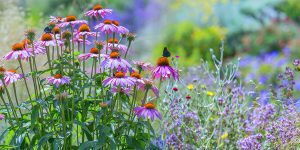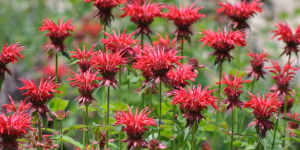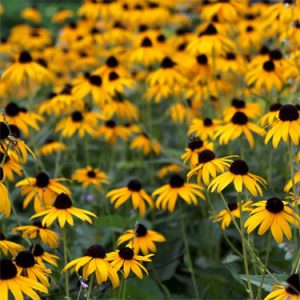Why Pollinator Gardens Matter
Pollinators, like bees, butterflies, moths, beetles, hummingbirds, and more, play a vital role in the health of our ecosystems and food systems. But across the globe, these essential creatures are in trouble. Populations are shrinking due to a mix of habitat loss, pesticide use, disease, and climate change. Many pollinators, especially native bees, are struggling to find the food and nesting spaces they need to survive.
The good news? Gardeners can absolutely help turn things around.
You don’t need a big yard or a fancy setup to make a difference. Even a small garden bed or a couple of planters can give bees and butterflies a much-needed place to land. Pollinator gardens bring life into your space and support the health of your neighborhood’s ecosystem. Every flower you plant adds to the patchwork of green spaces that help local wildlife survive and thrive.
Why Pollinator Gardens Matter to Local Ecosystems
Pollinator gardens bring in bees and butterflies, but their impact goes far beyond the flowers. They help support the whole ecosystem, from the soil under your feet to the birds in the trees.
These plantings support local food webs by feeding insects, birds, amphibians, and even small mammals. The whole system benefits when pollinators have access to the plants they rely on. Flowers bloom more abundantly, birds find more insects to feed their young, and soil microbes thrive under diverse root systems.
Plus, pollinator gardens help reduce our reliance on synthetic fertilizers and pesticides by promoting natural balance. Even modest backyard gardens can serve as crucial “green corridors” that reconnect fragmented habitats, especially in suburban and urban areas like ours here in Chicagoland.
What Are Specialist Bees?
Among the many pollinators that benefit from these green spaces, native bees play one of the most important roles. And within that group, some bees have incredibly specific needs.
Known as specialist bees, these pollinators are native species that have evolved to feed from very specific plants. One great example is the squash bee (Peponapis pruinosa), which only visits plants in the squash family. These bees are incredibly efficient pollinators, but they can’t simply switch to another flower if their preferred plant disappears.
That’s why plant selection matters so much. Without their native plant partners, specialist bees simply vanish. Creating a garden that includes those key native plants is one of the best ways to protect these vulnerable pollinators.

Why Native Plants Matter to Specialist Bees
Native plants are perfectly matched to the needs of native pollinators. They offer the right kinds of nectar and pollen, and they bloom in sync with the lifecycle of the insects that depend on them.
In contrast, many imported or hybridized plants either lack nutritional value or flower at times that don’t align with the local bee population’s needs. That means even a flower-filled garden could be lacking the real resources pollinators rely on.
Choosing native plants brings real benefits to your garden and the wildlife around it. These plants offer the food and habitat that local pollinators depend on, and in many cases, can’t find anywhere else.
Meet the Other Pollinators
Bees might be the MVPs of the pollination world, but they’re far from the only players.
Butterflies, moths, hummingbirds, beetles, and even some flies are essential pollinators, too. Butterflies tend to favor flat, open-faced flowers like milkweed, while hummingbirds love red, tubular blooms like bee balm. Some beetles and flies even take on pollinating duties in cooler or wetter conditions when bees are less active.
By planting a wide variety of flower shapes, sizes, and colors, you create a garden that speaks the love language of every kind of pollinator.
Your Garden Can Make a Difference
In a time when so many natural habitats are shrinking, every flower bed, parkway strip, or schoolyard garden can serve as a lifeline. When you plant a pollinator garden, you’re not just adding beauty to your space, you’re actively rebuilding the broken links in our ecosystem.
Pollinator gardens offer an easy, beautiful way to make a difference. You can plant in a backyard, a schoolyard, or a shared community space and still have a positive impact. Every bloom helps restore balance and brings us one step closer to healthier local ecosystems.
How to Start Your Own Pollinator Garden
Creating a thriving pollinator garden doesn’t take a green thumb or a huge budget. With the right approach, anyone can grow a space that supports bees, butterflies, hummingbirds, and more. Here’s your step-by-step guide to building a pollinator-friendly garden that works beautifully in Chicagoland’s Zone 5 climate.
Step 1: Find the Perfect Spot
Pollinators love sunshine. Choose a spot that gets at least 6 hours of direct sun each day, the more the better. Full sun encourages the best flowering and keeps nectar production high, which keeps pollinators coming back.
Think about visibility, too. If you can see your garden from a kitchen window or patio, you’ll enjoy watching all the activity it brings. Avoid windy or heavily trafficked areas when possible, and look for a location where the garden won’t be shaded out by trees or buildings.

Refrain from pruning during late summer, fall, or early spring, as the buds for next year’s flowers are already developing. Over-pruning during these periods can significantly reduce flowering potential.
Best Tools for Pruning Hydrangeas
Using the right tools for pruning hydrangeas makes the job easier, safer, and more effective. Proper tools ensure clean cuts, which promote faster healing and reduce the risk of disease. Here’s a breakdown of the best tools to have on hand:
- Hand Pruners
For light pruning tasks, such as trimming spent flower heads or cutting thin stems, bypass hand pruners are a must. Their sharp, scissor-like blades make clean cuts without crushing the plant tissue, which is ideal for maintaining healthy growth. - Loppers
When dealing with thicker branches, loppers provide the extra power you need. These long-handled tools can easily cut stems up to 1-2 inches in diameter, making them perfect for older, woody hydrangea stems. Look for loppers with ergonomic handles for comfort during extended use. - Pruning Saw
A pruning saw is the tool of choice for cutting through very thick or tough stems that hand pruners and loppers can’t handle. These saws are compact, sharp, and designed for clean cuts on larger branches. - Gloves
Sturdy gardening gloves protect your hands from cuts, scrapes, and potential irritation from hydrangea sap. Choose gloves with a snug fit to maintain dexterity while working. - Cleaning Supplies
Disinfecting tools between cuts prevents the spread of disease. Keep a cloth and rubbing alcohol or a solution of water and bleach nearby to wipe blades clean.
Investing in high-quality tools and keeping them sharp ensures your hydrangeas receive the best care, resulting in healthier plants and beautiful blooms.
Common Mistakes Gardeners Make When Pruning Hydrangeas—and How to Avoid Them
Even with the best intentions, it’s easy to make mistakes when pruning hydrangeas. A snip in the wrong place or at the wrong time can mean fewer blooms or a plant struggling to recover. Let’s tackle some of the most common errors and how to steer clear of them, so your hydrangeas thrive year after year.

Step 2: Choose Pollinator-Friendly Plants
Variety is key. Aim for a mix of native plants that bloom from early spring through late fall. This keeps food available all season long. Include flowers in a range of shapes, sizes, and colors to appeal to different kinds of pollinators, like bees, butterflies, moths, hummingbirds, and more.
Focus on native species whenever possible. Native plants are adapted to local conditions and provide the exact resources that native pollinators, especially specialist bees, rely on. Some great choices for Zone 5 include Purple Coneflower, Bee Balm, and Black-Eyed Susan (more on these later in our plant list!).
Pro tip: Plant in clusters or drifts. A group of 3–5 of the same plant will catch more attention than scattered singles and make for easier foraging.
Step 3: Prepare Your Soil Naturally
Good soil means healthier plants and stronger blooms. Start by clearing out any existing sod, weeds, or invasive plants. Then loosen the top 6–12 inches of soil using a garden fork or spade.
If you can, skip synthetic fertilizers and instead amend with compost or well-rotted leaf mulch. This improves soil structure, boosts nutrients naturally, and encourages beneficial microbes and insects. Also, avoid tilling deeply, it can disrupt soil health and disturb ground-nesting bees.
Step 4: Plant with a Purpose
When you’re ready to plant, think layers and variety. Include tall plants, medium-height bloomers, and low-growing ground covers to create visual interest and shelter for insects. Keep water needs in mind, grouping plants with similar moisture preferences together.
Leave some open ground, too. Many native bees nest right in the soil. If your space allows, you can also include small logs, brush piles, or a patch of bare sandy soil as nesting habitat.
Spacing matters: give your plants room to grow to their mature size and avoid overcrowding, which can reduce airflow and invite disease.
Step 5: Say No to Chemicals
Skip the pesticides, herbicides, and synthetic fertilizers. These products often harm pollinators directly or reduce the number of insects they rely on for food.
If pests become a problem, try organic solutions like neem oil, insecticidal soap, or companion planting before reaching for anything stronger. Healthy, diverse gardens tend to attract natural predators that keep pests in check, so patience and balance go a long way.
Step 6: Provide Water and Shelter
Like all creatures, pollinators need water to survive. A shallow dish with a few stones for landing spots works great. Birdbaths or rainwater catch basins also help. Just be sure to clean them regularly to prevent mosquitoes.
Shelter is just as important. Native bees often nest in hollow stems, dead wood, or bare soil, while butterflies may seek cover under leaves or along fence lines. Avoid too much cleanup in fall; leaving some plant stalks and leaf litter in place can protect overwintering insects.
Step 7: Let Nature Lead the Way
Pollinator gardens don’t have to be flawless. The goal is to create a space where nature feels welcome and pollinators can thrive, not a manicured landscape that looks the same year-round.
Observe what’s working and what’s not. Some plants might self-seed or shift over time. Let them. Watch which flowers attract the most activity and consider planting more of those. Resist the urge to over-tidy or control everything. In this garden, wild is wonderful.
Bonus: Top Pollinator Plants for Zone 5 Gardens
Choosing the right plants is one of the best ways to bring your pollinator garden to life. These three native favorites are reliable bloomers, loved by pollinators, and well-suited to our climate here in northern Illinois. Plus, they’re available right here at Platt Hill Nursery.
Purple Coneflower (Echinacea purpurea)

With its bold, daisy-like flowers and long bloom time, Purple Coneflower is a magnet for bees, butterflies, and even goldfinches that snack on the seeds in late summer. This hardy perennial thrives in full sun and tolerates a wide range of soils, including drought conditions once established. Its sturdy stems and vibrant pink-purple petals make it a striking centerpiece in any garden bed.
Bee Balm (Monarda)

Black-Eyed Susan (Rudbeckia)

Final Tips for a Thriving Pollinator Garden
Pollinator gardens grow best when you let nature take the lead, but a few thoughtful touches will help yours truly flourish:
- Mix in all bloom seasons: Aim for early spring, mid-summer, and late-fall flowers to keep food available all season long.
- Deadhead wisely: Removing spent blooms can encourage more flowering, but be sure to leave some at the end of the season for seed-eating birds.
- Leave the leaves: In fall, skip the full cleanup. Leaf litter and plant stems provide shelter for overwintering pollinators.
- Skip the mulch overload: Use mulch sparingly, especially around ground-nesting bees. Bare soil patches are helpful!
- Keep learning: Every season is a chance to watch, learn, and adapt. Pollinators will show you what they love. You just have to pay attention outside your windows!
Building a pollinator garden is one of the most rewarding ways to connect with nature, boost local biodiversity, and bring color and life to your landscape. It’s good for the planet and great for the soul.
Ready to get started? Visit Platt Hill Nursery in Bloomingdale or Carpentersville, or shop online to find the native plants, pollinator favorites, and gardening advice you need to grow something amazing. We’re here to help you every step of the way.


